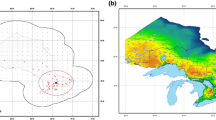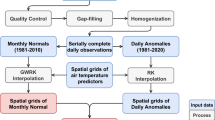Abstract
Air temperature is an important indicator of climate change, as well as for understanding changes in hydrology, ecology, and other natural systems. However, meteorological stations that provide reliable temperature observations are usually sparse in areas of complex terrain, thus limiting our ability to quantify high spatial resolution temperature variability in these regions. Here, we apply three statistical downscaling methods to daily air temperature output from the sixth Coupled Model Intercomparison Project (CMIP6), validated with 22 meteorological stations over the Qilian Mountains. Based on different downscaling methods, we find RMSE and MAE are reduced as much as 59–66%, with the ratio of RMSE and MAE to the annual average temperature of stations decreasing from 147.9 to 61.0% and 143.3 to 64.7%, respectively, depending on the method. Compared to the original data, annual temperature based on the best downscaling methods differed by −2.85±3.61°C during the historical 1850–2014 period and, for the 2015–2100 projections, by 2.13±3.30°C for SSP1-2.6, −2.13±3.29°C for SSP2-4.5, −2.11±3.24°C for SSP3-7.0, and −2.12±3.23°C for SSP5-8.5. The downscaled annual air temperatures show a warming trend ranging 0.15–0.22°C/10 years for the historical experiment, 0.08–0.14°C/10 years for SSP1-2.6, 0.24–0.35°C/10 years for SSP2-4.5, 0.43–0.63°C/10 years for SSP3-7.0, and 0.52–0.76°C/10 years for SSP5-8.5 in the Qilian Mountains. These results indicate that the accuracy of the downscaled temperatures is improved compared to the original data. However, we also find that, compared with the downscaled data, the original projections have been overestimated.














Similar content being viewed by others
Data availability
Available on request.
References
Bolstad PV, Swift L, Collins F, Régnière J (1998) Measured and predicted air temperatures at basin to regional scales in the southern Appalachian mountains. Agric For Meteorol 91:161–176. https://doi.org/10.1016/S0168-1923(98)00076-8
Cao B, Gruber S, Zhang T (2017) REDCAPP (v1. 0): Parameterizing valley inversions in air temperature data downscaled from reanalyses. Geosci Model Dev 10:2905–2923. https://doi.org/10.5194/gmd-10-2905-2017
Cao B, Zhang T, Wu Q, Sheng Y, Zhao L, Zou D (2019) Permafrost zonation index map and statistics over the Qinghai–Tibet Plateau based on field evidence. Permafr Periglac Process 30:178–194. https://doi.org/10.1002/ppp.2006
Chu J, Xia J, Xu C-Y, Singh V (2010) Statistical downscaling of daily mean temperature, pan evaporation and precipitation for climate change scenarios in Haihe River, China. Theor Appl Climatol 99:149–161. https://doi.org/10.1007/s00704-009-0129-6
Collins WJ, Lamarque J-F, Schulz M, Boucher O, Eyring V, Hegglin MI, Maycock A, Myhre G, Prather M, Shindell D (2017) AerChemMIP: quantifying the effects of chemistry and aerosols in CMIP6. Geosci Model Dev 10:585–607. https://doi.org/10.5194/gmd-10-585-2017
Coppola E, Giorgi F (2010) An assessment of temperature and precipitation change projections over Italy from recent global and regional climate model simulations. Int J Climatol 30:11–32. https://doi.org/10.1002/joc.1867
Dodson R, Marks D (1997) Daily air temperature interpolated at high spatial resolution over a large mountainous region. Clim Res 8:1–20. https://doi.org/10.3354/cr008001
Eyring V, Bony S, Meehl GA, Senior CA, Stevens B, Stouffer RJ, Taylor KE (2016) Overview of the Coupled Model Intercomparison Project Phase 6 (CMIP6) experimental design and organization. Geosci Model Dev 9:1937–1958. https://doi.org/10.5194/gmd-9-1937-2016
Fiddes J, Gruber S (2014) TopoSCALE v. 1.0: downscaling gridded climate data in complex terrain. Geosci Model Dev 7:387–405. https://doi.org/10.5194/gmd-7-387-2014
Gao L., Hao L., Chen X.-w. (2014) Evaluation of ERA-interim monthly temperature data over the Tibetan Plateau. J Mt Sci 11:1154-1168.https://doi.org/10.1007/s11629-014-3013-5
Gao X, Shi Y, Giorgi F (2011) A high resolution simulation of climate change over China. Sci China Earth Sci 54:462–472. https://doi.org/10.1007/s11430-010-4035-7
Gao L, Bernhardt M, Schulz K (2012) Downscaling ERA-Interim temperature data in complex terrain. Hydrol Earth Syst Sci Discuss 9. https://doi.org/10.5194/hessd-9-5931-2012
Gao L, Schulz K, Bernhardt M (2014) Statistical downscaling of ERA-interim forecast precipitation data in complex terrain using lasso algorithm. Adv Meteorol 2014. https://doi.org/10.1155/2014/472741
Gao L, Wei J, Wang L, Bernhardt M, Schulz K, Chen X (2018) A high-resolution air temperature data set for the Chinese Tian Shan in 1979–2016. Earth Syst Sci Data 10:2097–2114. https://doi.org/10.5194/essd-10-2097-2018
Grachev AA, Andreas EL, Fairall CW, Guest PS, Persson POG (2013) The critical Richardson number and limits of applicability of local similarity theory in the stable boundary layer. Bound-Layer Meteorol 147:51–82. https://doi.org/10.1007/s10546-012-9771-0
Hagemann S, Machenhauer B, Jones R, Christensen O, Déqué M, Jacob D, Vidale PL (2004) Evaluation of water and energy budgets in regional climate models applied over Europe. Clim Dyn 23:547–567. https://doi.org/10.1007/s00382-004-0444-7
Hay LE, Clark M (2003) Use of statistically and dynamically downscaled atmospheric model output for hydrologic simulations in three mountainous basins in the western United States. J Hydrol 282:56–75. https://doi.org/10.1016/S0022-1694(03)00252-X
Ishida T, Kawashima S (1993) Use of cokriging to estimate surface air temperature from elevation. Theor Appl Climatol 47:147–157. https://doi.org/10.1007/BF00867447
Kiefer MT, Zhong S (2015) The role of forest cover and valley geometry in cold-air pool evolution. J Geophys Res-Atmos 120:8693–8711. https://doi.org/10.1002/2014JD022998
Kunkel KE (1989) Simple procedures for extrapolation of humidity variables in the mountainous western United States. J Clim 2:656–669. https://doi.org/10.1175/1520-0442(1989)002<0656:SPFEOH>2.0.CO;2
Lareau NP, Crosman E, Whiteman CD, Horel JD, Hoch SW, Brown WO, Horst TW (2013) The persistent cold-air pool study. Bull Am Meteorol Soc 94:51–63. https://doi.org/10.1175/BAMS-D-11-00255.1
Li B, Sun Y, Guo W, Shan X, Wang P, Pang S, Jia R, Zhang G (2017) The mechanism and verification analysis of permafrost-associated gas hydrate formation in the Qilian Mountain, Northwest China. Mar Pet Geol 86:787–797. https://doi.org/10.1016/j.marpetgeo.2017.05.036
Lin P, Wei J, Yang ZL, Zhang Y, Zhang K (2016) Snow data assimilation-constrained land initialization improves seasonal temperature prediction. Geophys Res Lett 43:11,423–11,432. https://doi.org/10.1002/2016GL070966
Liston GE, Elder K (2006) A distributed snow-evolution modeling system (SnowModel). J Hydrometeorol 7:1259–1276. https://doi.org/10.1175/JHM548.1
Mahrt L, Vickers D, Nakamura R, Soler M, Sun J, Burns S, Lenschow D (2001) Shallow drainage flows. Bound-Layer Meteorol 101:243–260. https://doi.org/10.1023/A:1019273314378
Mao K, Tang H, Wang X, Zhou Q, Wang D (2008) Near-surface air temperature estimation from ASTER data based on neural network algorithm. Int J Remote Sens 29:6021–6028. https://doi.org/10.1080/01431160802192160
Maraun D, Wetterhall F, Ireson A, Chandler R, Kendon E, Widmann M, Brienen S, Rust H, Sauter T, Themeßl M (2010) Precipitation downscaling under climate change: recent developments to bridge the gap between dynamical models and the end user. Rev Geophys 48. https://doi.org/10.1029/2009RG000314
Maurer EP, Wood AW, Adam JC, Lettenmaier DP, Nijssen B (2002) A long-term hydrologically based dataset of land surface fluxes and states for the conterminous United States. J Clim 15:3237–3251. https://doi.org/10.1175/1520-0442(2002)015<3237:ALTHBD>2.0.CO;2
Minder JR, Mote PW, Lundquist JD (2010) Surface temperature lapse rates over complex terrain: Lessons from the Cascade Mountains. J Geophys Res-Atmos 115. https://doi.org/10.1029/2009JD013493
Mooney PA, Mulligan FJ, Fealy R (2011) Comparison of ERA-40, ERA-Interim and NCEP/NCAR reanalysis data with observed surface air temperatures over Ireland. Int J Climatol 31:545–557. https://doi.org/10.1002/joc.2098
Mote PW (2006) Climate-driven variability and trends in mountain snowpack in western North America. J Clim 19:6209–6220. https://doi.org/10.1175/JCLI3971.1
Prihodko L, Goward SN (1997) Estimation of air temperature from remotely sensed surface observations. Remote Sens Environ 60:335–346. https://doi.org/10.1016/S0034-4257(96)00216-7
Prince S, Goetz S, Dubayah R, Czajkowski K, Thawley M (1998) Inference of surface and air temperature, atmospheric precipitable water and vapor pressure deficit using Advanced Very High-Resolution Radiometer satellite observations: comparison with field observations. J Hydrol 212:230–249. https://doi.org/10.1016/S0022-1694(98)00210-8
Rolland C (2003) Spatial and seasonal variations of air temperature lapse rates in Alpine regions. J Clim 16:1032–1046. https://doi.org/10.1175/1520-0442(2003)016<1032:SASVOA>2.0.CO;2
Rong Y, Su H, Zhang R, Tian J, Chen S, Yang Y, Li B (2011) A new physically based method for air temperature downscaling, 2011 IEEE International Geoscience and Remote Sensing Symposium. IEEE, pp 1814–1817. https://doi.org/10.1109/IGARSS.2011.6049474
Souvignet M, Gaese H, Ribbe L, Kretschmer N, Oyarzun R (2010) Statistical downscaling of precipitation and temperature in north-central Chile: an assessment of possible climate change impacts in an arid Andean watershed. Hydrol Sci J–J Sci Hydrol 55:41–57. https://doi.org/10.1080/02626660903526045
Tabony R (1985) Relations between minimum temperature and topography in Great Britain. J Climatol 5:503–520. https://doi.org/10.1002/joc.3370050504
Vicente-Serrano SM, Saz-Sánchez MA, Cuadrat JM (2003) Comparative analysis of interpolation methods in the middle Ebro Valley (Spain): application to annual precipitation and temperature. Clim Res 24:161–180. https://doi.org/10.3354/cr024161
Wang K, Liang S (2008) An improved method for estimating global evapotranspiration based on satellite determination of surface net radiation, vegetation index, temperature, and soil moisture. J Hydrometeorol 9:712–727. https://doi.org/10.1175/2007JHM911.1
Wang X, Vandenberghe D, Yi S, Vandenberghe J, Lu H, Van Balen R, Van den Haute P (2013) Late Quaternary paleoclimatic and geomorphological evolution at the interface between the Menyuan basin and the Qilian Mountains, northeastern Tibetan Plateau. Quat Res 80:534–544. https://doi.org/10.1016/j.yqres.2013.08.004
Yang T, Li H, Wang W, Xu CY, Yu Z (2012) Statistical downscaling of extreme daily precipitation, evaporation, and temperature and construction of future scenarios. Hydrol Process 26:3510–3523. https://doi.org/10.1002/hyp.8427
Code availability
Not applicable.
Funding
This study was supported by the National Key R&D Program of China (2019YFC0507403), the National Natural Science Foundation of China (grant no. 42171120, 42161160328, 42101134), and the Fundamental Research Funds for the Central Universities (lzujbky-2021-72, lzujbky-2021-ct13).
Author information
Authors and Affiliations
Contributions
Haodong Jin: methodology, writing—original draft, validation, writing—review and editing; Xiaodong Li: writing—review and editing; Oliver W. Frauenfeld: writing—review and editing; Yaohua Zhao: resources; Cong Chen: resources; Ran Du: resources; Jun Du: writing—review and editing; Xiaoqing Peng: writing—review and editing, funding acquisition.
Corresponding authors
Ethics declarations
Ethics approval
We confirm that this article is an original research and has not been published or presented previously in any journal or conference in any language.
Consent to participate
All the authors consent to participate in this process.
Consent for publication
Authors agree to publish this paper.
Competing interests
The authors declare no competing interests.
Additional information
Publisher’s note
Springer Nature remains neutral with regard to jurisdictional claims in published maps and institutional affiliations.
Rights and permissions
About this article
Cite this article
Jin, H., Li, X., Frauenfeld, O.W. et al. Comparisons of statistical downscaling methods for air temperature over the Qilian Mountains. Theor Appl Climatol 149, 893–896 (2022). https://doi.org/10.1007/s00704-022-04081-w
Received:
Accepted:
Published:
Issue Date:
DOI: https://doi.org/10.1007/s00704-022-04081-w












